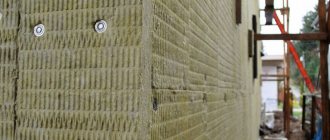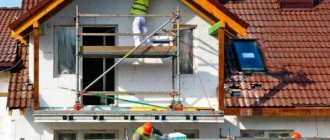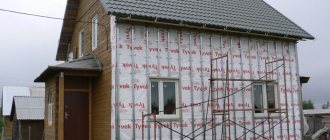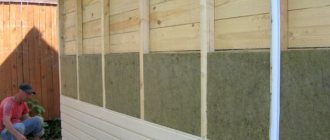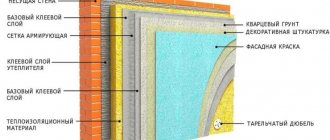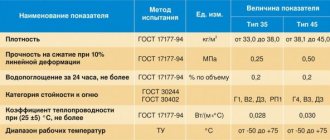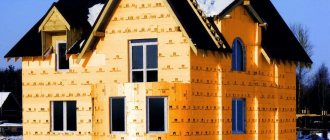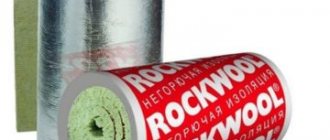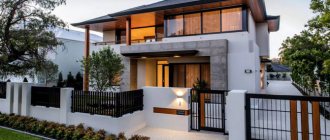Insulating the exterior of the house façade with mineral wool under plaster ensures heat retention in a residential building and durability of the finish. The building material is distinguished by high heat-insulating and sound-proofing properties, vapor permeability, and environmentally friendly composition. The work uses basalt, slag or fiberglass wool.
What is this process
Cotton wool for insulation is used when finishing the façade parts of a house to increase thermal protection, comfort, and maintain a stable indoor microclimate. When performing work, experts recommend following the sequence of the process to create a single multilayer structure.
Standard technology includes the application of 3 main layers:
- heat insulating;
- reinforcing;
- decorative (finishing).
Mineral wool insulation for finishing wall panels outside the house is made in the form of slabs with dimensions of 0.6x1.2 or 0.5x1 m. The thickness of the mineral wool reaches 50-150 mm. Facade finishing will increase the fireproof characteristics of the building and improve the level of sound insulation in the premises.
When performing external insulation of a building before applying decorative plaster, it will increase the aesthetics of the house. The strength of mineral wool differs depending on the brand of building material and is (0.08-06 kg/sq. m). Manufacturers offer materials with different densities (35-100 kg/cubic m) for various types of buildings and climatic conditions of the region.
Recommendations and common mistakes
Laying insulation on the facade requires precise adjustment of the slab dimensions. The most common mistake made by beginners is incorrect planning and cutting of the material before laying mineral wool on the walls. Often the space around the window is made up of scraps of insulation. Whereas, according to technology, the perimeter of a window or doorway should be sheathed with solid slabs with cut out corners. In places where window openings are bypassed, the vertical distance from the corner of the window to the horizontal edge must be at least 150 mm.
The second mistake is not applying the glue carefully enough. To ensure that the places where mineral wool is glued to the facade are strong, you need to rub the slabs as gently as possible, but at the same time with force, with small amounts of facade glue, then most of the adhesive mass is applied in several “splashes” or along the perimeter of the slab.
Advantages and disadvantages of facade insulation with mineral wool under plaster
Insulating a house with mineral wool under plaster has the following advantages:
- high thermal insulation characteristics due to low thermal conductivity;
- increased sound insulation;
- increasing the level of fire safety;
- environmental friendliness of the composition;
- durability of the material (service life reaches 50 years);
- resistance to fungus, damage by rodents, insects;
- increased vapor permeability due to the non-flammability of chemical components;
- ease of installation;
- resistance to direct sunlight and external factors, temperature changes;
- safety of the material (harmful fumes are formed only when the cotton wool is heated above +300°C);
- the presence of varieties of products under the surface from different types of materials (brick, wood, concrete slabs);
- The shrinkage of the insulation is low, therefore, with prolonged use, the properties of sound insulation and fire resistance do not decrease.
The list of disadvantages of mineral wool:
- during operation, cracks appear on the insulation in the absence of a reinforcing layer;
- without treatment with a hydrophobic agent, the thermal insulation parameters decrease over time;
- the material may change volume over time.
Preparing the walls
The first step is to do a little cleaning of the surface. This is done in order to improve the adhesion of the glue and remove dust and dirt as much as possible. Otherwise, the mineral wool, like a sponge, will absorb everything that remains under the insulation layer.
The façade preparation process is as follows:
- We dryly clean with a brush with stiff bristles all remnants of masonry mortar, efflorescence and traces of paint;
- Using a roller we apply a deep penetration primer to the façade walls. There is no need to save money; the better the surface is saturated, the easier it will be to glue the slabs.
Priming is performed twice, and you should try to apply the second layer in the direction perpendicular to the first treatment. It is better to work in the absence of wind and sun; it is believed that in such conditions the primer dries more slowly, penetrates well into the wall material and does not collect dust.
Technology of facade insulation with cotton wool
Insulation of the external walls of a building is carried out in compliance with the following steps:
- preparing wall panels for plastering;
- installation of profile elements;
- installation of external sheathing;
- preparation of insulating materials;
- fixing mineral wool with dowels;
- strengthening the structure;
- applying a layer of primer before plastering.
Preparing the surface for facade plastering
Before starting work, it is recommended to prepare the surface. The facades are cleaned of dust, dirt, and unevenness is eliminated. From the outer surface you will need to remove metal elements that may become rusty. The necessary metal elements are left, while experts recommend using a non-acrylic-based plaster composition. Old paint, plaster and other finishing materials are removed with a spatula or solvent.
After completing the cleaning of the surface, markings are carried out into zones using sags (strong nylon ropes). The sags are pulled along reinforcing pins; after finishing work, the elements will need to be dismantled. The pins are fixed vertically and horizontally in accordance with the indicated points.
Installation of profile elements
At the next stage, the installation of profile elements is carried out. First, a base profile is installed, which is used as a base for the insulating layer. The aluminum element protects the insulation from getting wet and allows you to fix the structure. The profile will prevent deformation of facades and tightly join layers of plaster.
External sheathing device
To securely fix the insulated material, you will need to install metal lathing and corners. The wall must be marked for insulation boards and the dowels and corners must be secured. Mineral wool slabs are placed according to the principle of brickwork with fixation along vertical seams.
Preparing insulation material for the facade under plaster
The preparation of insulating blocks involves the use of specialized adhesive compositions. To process mineral wool, Ceresit CT 180 glue is often used. The composition is applied with a spatula in a thin layer over the surface of the slab. Then point areas are formed for gluing to the facade.
Where the insulation joins the window block, it is necessary to ensure that the edge of the opening does not border on the joints of the mineral wool. If the technology for laying wool is not followed, cracks may appear on the structure. For some parts of the facade, it will be necessary to cut mineral wool blocks of atypical configurations.
Workplace equipment
For high-quality insulation of the façade structure of a building, experts recommend installing scaffolding in compliance with safety regulations. It is recommended to check the soil under the supports. Safety railings are also installed at the construction site.
Fastening insulating material with dowels
At the next stage, dowels are installed to secure the mineral wool blocks. Additional reinforcement is used to increase the safety of the façade structure. The weight of a slab made of cotton wool is 2 times greater than that of foam blocks, therefore, according to safety regulations, additional fixation is required. The dowels are attached 24 hours after the adhesive has dried. 1 slab will require at least 8 fasteners.
At the stage of preparation for insulation, holes are made under the anchors with a depth of 1.5-2 cm greater than the length of the dowel. Then fasteners are inserted into the openings. Dowels are installed in the central part of the mineral wool blocks and places of additional connections of elements.
Strengthening the structure
At the stage of building insulation, patches are installed. The elements allow you to support the façade structure in the corners where openings and walls meet. You will need to apply glue in areas larger than the size of the reinforcement mesh. After applying the adhesive base, the mesh is installed. After strengthening difficult areas, the main reinforcing mesh is installed. An adhesive base is applied to the mineral wool using a staple and the reinforcing mesh is fixed.
Applying primer before applying plaster
For high-quality adhesion of the plaster mortar and mineral wool, experts recommend treating the insulating layer with a special primer. Treatment can be performed in 2 layers to increase the shelf life of the structure. Then you can plaster the surfaces and cover them with a finishing layer using a varnish mixture.
Safety precautions for thermal insulation
Stone wool is fixed on facade structures while observing safety precautions:
- work is carried out using special protective gloves to prevent damage;
- fixation of stone facade material is carried out only with safety glasses so that sharp particles do not damage the eyes;
- when cutting mineral wool into blocks and then fixing them, it is recommended to use a protective mask;
- When working with glass wool, a protective suit made of dense fabric compositions is required.
What tools will you need?
To carry out installation work you will need:
- guide profile elements;
- construction level;
- adhesive composition;
- mineralized wool;
- mesh for reinforcement;
- spatulas, plaster composition for the facade;
- dowels
Review of the best thermal insulation options
The required material must combine lightness, good insulating properties, resistance to moisture and external influences, and durability. Preference is given to rigid slabs that retain their shape unchanged throughout their entire service life, ideally non-flammable. Stone wool and polystyrene foam of different brands have qualities suitable for facades; for general purposes, they have slightly different installation and finishing technology. The cake scheme includes three main layers: slabs, reinforced mesh and plaster mortar, the latter can combine the function of protection and decoration or, conversely, require additional painting.
The advantages of polystyrene foam include a closed cell structure, moisture resistance, low density, easy installation and affordable cost. The maximum effect is achieved by using specialized locking and tongue-and-groove systems with milled external surfaces that eliminate the formation of cold bridges and better adhere to the plaster. TechnoNIKOL Carbon, Penoplex Facade and their analogues have suitable characteristics, but if necessary, ordinary brands (PSB, Knauf) with a density of 25 kg/m3 are also suitable. The disadvantages of this option include not the best resistance to mechanical damage, flammability and the need for additional fasteners and mesh reinforcement.
The use of basalt wool for façade insulation followed by plastering is chosen if there is a desire to maintain the permeability of wall materials or high fire safety requirements. In this case, not just any type of mineral wool is suitable: for obvious reasons, they must be hydrophobized, the required minimum density is 130 kg/m3: the stiffer they are, the better. In order to reduce the load on the foundation, specialized grades can be used - lightweight on the one hand, rigid and designed for applying mortar on the other.
The moisture resistance of such basalt slabs is enhanced due to the special arrangement of fibers and impregnation with special compounds; a small part of the absorbed sediment is not retained inside. Despite the higher adhesive strength than smooth foam, it still needs a reinforced mesh, in particular, when covering the main facade plaster with a finish of a different brand and/or in order to increase the strength of the outer layer.
The considered disadvantages of stone wool include deterioration in insulating properties during operation and a slightly worse thermal conductivity coefficient compared to polystyrene foam. This insulation is more expensive and places a higher load on foundation structures.
Comparison of main characteristics:
| Indicator name | TechnoNikol | |
| Basalt slabs Technofas | Extruded polystyrene foam Carbon Eco (for facade and plinth) | |
| Thermal conductivity coefficient, W/m°C | 0,038-0,041 | 0,034 |
| Material density, kg/m3 | 140 | 30 |
| Compressive strength, kPa | 45 | 250 |
| Temperature range of application, °C | -60 to +200 | From -70 to +75 |
| Vapor permeability coefficient, mg/m h Pa | 0,3 | 0,011 |
| Flammability group | Ng | G4 |
Manufacturers
It is better to buy cotton wool from trusted manufacturers. Among them are both well-known brands and mineral wool brands that are unfamiliar to the mass consumer.
Rockwool. (Denmark) produces insulation from basalt and gabbro fibers at production facilities located in several countries, including Russia. Features of insulating mats are:
- low thermal conductivity;
- good absorption of air noise;
- resistance to open flame (flammability class NG);
- long service life;
- environmental cleanliness.
Paroc. A manufacturer of basalt wool from Finland () offers consumers mats for residential construction and acoustic insulation of recording studios.
The insulation is characterized by a low thermal conductivity coefficient, fire resistance, and durability. It is almost impossible to find counterfeit products on sale - the company very carefully monitors the market for counterfeits. Unfortunately, for the average consumer the price of insulation is too high.
Isover. The leader in sales of mineral wool in Europe is a transnational company registered in France, which has its production facilities in Russia. The product has the best balance between price and quality.
TechnoNIKOL. The brand of thermal and waterproofing materials "TechnoNIKOL" belongs to Russian business, but is produced in many European countries (Lithuania, Belarus, Czech Republic, England). Among the huge product line, mineral wool insulation occupies a significant place. Modern equipment and careful quality control allowed the company to enter the TOP 5 largest suppliers of mineral wool to the construction market of Europe and the CIS countries.
IZOVOL. produces basalt insulation in Russia. The product has an affordable price and good quality. The line of insulation products includes mats produced separately for facades, roofs, floors, and foundations.
All quality characteristics meet the requirements of EU and Russian standards. A slight shedding of fibers during the installation process blurs the impression of quality. The manufacturer knows about the problem, but cannot fix it yet.
In addition to the listed brands, it is worth paying attention to the products of the brands “KNAUF” and “URSA”. It is very often bought for insulating timber houses.
From the middle price sector, experts note the insulation "Beltep" (Belarus). It has excellent rigidity, good vapor permeability, easy installation, and an affordable price.
Ready-made plastering systems
Often so-called plastering systems are sold in construction stores. These are kits that include glue, primer, insulation, plaster and paint, as well as other necessary materials. Usually they are produced by the same company or are ideally matched to each other in terms of technical parameters. The most famous plastering systems are:
- Rockwool. Includes several types of systems based on basalt wool with a thin or thick layer of plaster, as well as for facing with clinker tiles.
- "Senergy PPS". Ideal for low-rise buildings, it includes polystyrene foam insulation, adhesives, primers, and decorative protective plaster.
- Ceresit. Plaster complex based on extruded polystyrene foam.
- Caparol. Plaster system with polystyrene foam of different thicknesses.
Capatect facade insulation system
The cost of a plaster system depends on the manufacturer (domestic or foreign), the type of insulation, the type of plaster and the thickness of its layer. The so-called “warm plasters” for facades, into which vermiculite or perlite are additionally introduced, are more expensive.
Mineral wool reinforcement
After the entire surface is covered with thermal insulation and securely fixed, you need to prepare the facade for plaster. To do this, use a reinforcing fiberglass mesh with small cells and hydrophobic glue.
The corners are reinforced first. The glue is applied in a thin layer to the mineral wool. The size of the treated area should be 15–20 cm larger per piece of mesh. Then the reinforcing fabric is applied so that there is material of the same size on both sides of the corner.
Using a wide spatula, the mesh is pressed into the glue. It is strictly forbidden to apply the mesh first and then apply the glue. This reduces the effectiveness of the reinforcement. Next, they begin to apply fiberglass to the entire surface of the walls. Everything is done using the same technology as the corners. The material needs to be joined with an overlap of 10–15 cm.
How to insulate a house outside with mineral wool
Over the years, and after numerous cycles of changing temperature conditions, the outer wood covering has lost its original properties. This is due to the fact that a large number of large, deep cracks appear on wood material, namely logs or beams, under the influence of various atmospheric changes.
It follows from this that in most cases, mineral wool is chosen to insulate the facade of a wooden house, and vinyl siding is chosen for the decorative outer surface. Which is not very expensive in price and has a fairly long service life.
And yet, the finishing material is easy to install and, if one of the panels is damaged, it can be easily replaced with a new one. The technology of such insulation has advantages that make it particularly unique and individual:
• respect for the environment;
• fire resistance (it increases fire safety outside the house);
• the ability to perform any work regardless of atmospheric changes (strong tropical torrential rains are an exception; when choosing to work with cotton wool, the entire material will most likely become wet);
• ease of installation;
• materials (siding and mineral wool) have vapor permeability properties.
For full effect, the design must have at least one of four insulating layers: insulation; wet membrane; wind protection. All installation materials are mounted on a frame, a specially prepared metal or wooden profile. It is this installation that protects the wood from excess moisture and allows the walls to “breathe.”
Preparatory work
Preparing walls for insulation with plaster to insulate the walls from the inside is carried out in the same way as before applying a conventional cement-sand mixture to their surfaces. If the old plaster is peeling, it should be removed. If not, then warm plaster can be applied over the existing layer.
The purpose of the preparatory work is to improve the adhesion of the insulating coating to the base surface of the walls. To do this, each of them needs to be filled with shingles or narrow slats of 5 mm, thus obtaining a space on which the plaster mixture will be well held. After this, it is necessary to stretch the mesh on the manufactured frame and fix it with nails, driving them into the slats.
The fastening step is assumed to be 10 cm, it must be done in a checkerboard pattern. The mesh can be woven or metal with cells of 50x50 mm. It is recommended to use metal mesh, as woven mesh is less durable and adheres too tightly to the wall surface.
To make it possible to level the plaster layer on the walls, it is necessary to install beacon profiles. They need to be pressed into a mortar mixture such as Ceresit or Rotband, applied in molds to the base every 0.3 m, and then leveled in a plane. Beacons should be installed vertically in increments of 0.2 m less than the length of the plaster rule.
Before plastering, the walls must be moistened generously with water. This is an additional measure to ensure high-quality adhesion of materials.
Plastering
If, after the glue has dried, with the reinforcing mesh fixed, large irregularities are visible, then rough plastering needs to be done. It will completely hide imperfections and make the surface smooth.
In cases where there are small differences, decorative plaster is applied immediately. In this case, you need to adhere to the principle of finishing. The method of application will depend on the selected texture.
If the composition did not have a coloring component, then after drying you need to apply 2-3 layers of paint. Here you need to be careful when choosing paint; it must be combined with the composition of the plaster.

